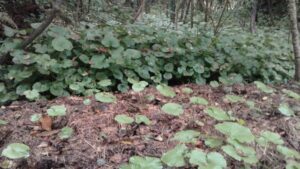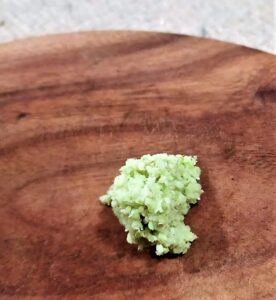West Cork Wasabi
by Caitriona Devery
You may know wasabi as the bright green nose-burning paste often served in Japanese restaurants alongside soy sauce to accompany sushi. In fact, this substance is usually made from horseradish with green food dye and only a small amount of wasabi powder.
The real deal, fresh wasabi, is less commonly found in Ireland but I recently met a man who’s been working to change that. West Cork man of mystery Alex Wasabi (not his real name) has been making a name for himself growing this rare item on a small scale in his Singing Frog Gardens since 2015. Watch for my next post on this blog for more information about the gardens and the treasure trove of unusual herbs and vegetables Alex has been cultivating alongside the Japanese delicacy.

Alex’s Wasabi plants
At some point in the early 2010’s Alex’s brother-in-law in Malaysia suggested he try to grow wasabi, which he had seen cultivated in New Zealand. The temperate, humid climate there is similar to Ireland, western Ireland in particular. As Alex told me, these moist, damp conditions that cause potato blight to thrive are also ideal for wasabi.
Situated in an ex-quarry, Alex’s mini-farm is small with a damp wooded glade at the rear on a slight hill with a fresh spring running through it. This wooded glade, or ‘trees in a bog’ as Alex puts it, proved perfect for his experiments. The trees provide shade, the spring moisture.
It’s a misconception, he says, that wasabi grows immersed in water. It needs ambient moisture, but thrives in well drained soil, as in the slightly inclined Singing Frog Gardens. The damp attracts raucous frogs, hence the farm’s name. Alex says his is the only forest-grown wasabi in Europe.

Wasabi garden
Wasabi itself takes about two years to grow to maturity. It has a reputation of being a little temperamental. Alex says one challenge is that it’s slow to respond to conditions, so doing something wrong – or right – might not manifest in the plant for six months or so, at which point it might be too late.
Another tricky issue is propagation. Wasabi plants keep growing year on year, but the older they get, the higher the risk of disease and deterioration. Alex harvests the seeds and refrigerates over winter before sowing and nurturing the baby wasabi plants to maturity.
The plant is part of the brassica family, which includes cabbage, horseradish and mustard. The part of the plant most commonly eaten is the rhizome or the lower stem. It looks like something from another planet, all gnarly and knobbly.

Cut wasabi rhizome
The leaves are similar to those of water lilies and it produces small white flowers with four petals in a cross shape. The leaves and flowers can be eaten too, although they are milder in flavour. It’s claimed that wasabi has antibacterial and anti-inflammatory properties.
Alex says that building the market and growing a customer base has almost been harder than getting the wasabi to grow. When he had his first successful crop in 2015 or so, he went to Cork city with a bag of wasabi and cold-called all the Japanese restaurants with samples. From these tentative beginnings, his business has taken root.
It is a luxury product and his main market so far has been high-end restaurants, including some Michelin-starred. He works with some of the best chefs in the country. Takashi Miyazaki, the Japanese genius of Cork city’s Miyazaki and Ichigo Ichie, used it to make wasabi ramen.
Ahmet Dede, now at Dede in Baltimore, created a wasabi-flavoured oatcake-like biscuit. Mike Tweedie is currently using it in Limerick’s Adare Manor, where it is grated at the table as a garnish for certain dishes. In Japan it’s also traditionally often grated like this, using an oroshigane, a sandpaper-like sharkskin attached to a wooden paddle.

Oroshigane, sharkskin grater
Alex gave me some fresh wasabi to try. I didn’t have a sharkskin grater to hand, so I used a metal microplane. The end result was I, I think, coarser than traditionally served but it was still wonderfully peppery and energising, tasting like a subtle version of horseradish. There is a milder yet still exhilarating nose-burn sensation. The flavour is complex and slightly bitter at the finish.

My grated wasabi
Wasabi is of course classically served with sushi and sashimi, but it can also be used as an ingredient in sauces and soups, in salad dressings and to flavour dishes like noodles and stir fries. Depending on how much you use, the effect can be subtle or potent. I grated some of the fresh wasabi into an olive oil and lemon dressing for a chicken salad with crunchy lettuce, cucumber and red peppers and it gave the dish a punchy kick.
Alex believes that wasabi is a plant with a lot of potential for Irish growers. He would like to build the wasabi community and has been exploring the cooperative model. If you’ve got a patch of boggy woodland and are curious about this fiery wonder plant, Alex is your man to talk to.
Growing production capacity is one side, growing the market is another. He is keen to build more links with chefs for his wasabi as well as for his other experiments into what can be grown in Ireland. He already works with other growers in West Cork to collectively manage distribution of all kinds of produce, which he says can be a real barrier to growers getting to market.
The Singing Frog Gardens long term dream is to export wasabi from Ireland to Japan. With Alex’s inventive approach to farming and willingness to try the unorthodox I wouldn’t be surprised if we see pale green wasabi from the Emerald Isle on a Tokyo menu in the years to come.
You can find Singing Frog Gardens on Instagram and online as West Cork Wasabi.
Caitríona Devery is a writer and radio broadcaster from Offaly but currently based in Dublin, with interests in food, culture, politics and environmentalism. Follow her on instagram: @everytreecat




